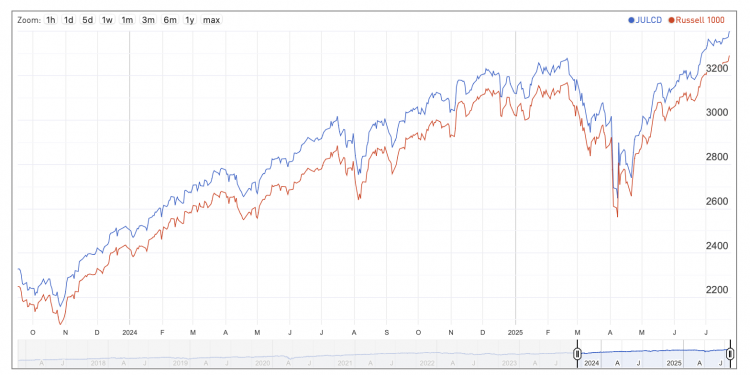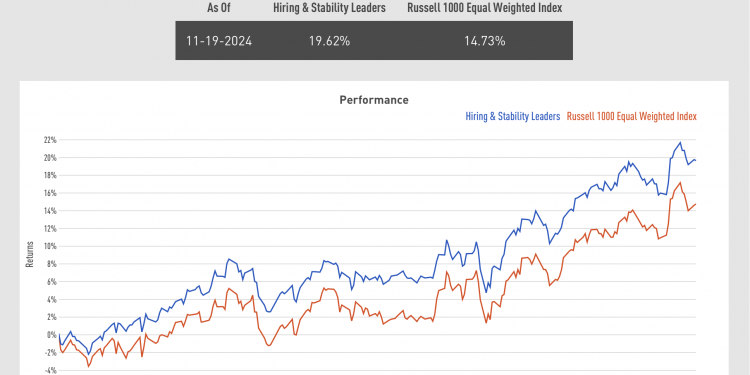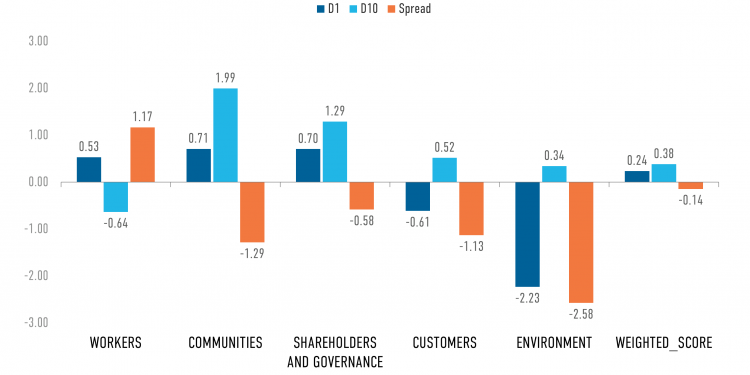Happy Together: Capital and Labor at JUST Companies
Background
The JUST 100 is the inaugural list of America’s most just companies recently released by JUST Capital. Using the Russell 1000 index of the largest publicly-traded corporations in America as its starting point, these 100 companies constitute the three highest-ranked companies within each of 32 industries, based on JUST Capital’s methodology, as well as the four highest-ranked fourth-place finishers. The JUST rankings reflect the preferences of the American public and place significant emphasis on worker pay & benefits, worker treatment, and leadership & ethics, among other important components. The full rankings and component list can be found on the JUST Capital site.
Is there a tradeoff between taking good care of workers and generating a high return on capital?
The question we explore in this article is whether there is a financial trade off between taking good care of workers and generating a high return on capital for shareholders. In particular, we examine the relationship between 2010 – 15 average Return-on-Invested Capital (ROIC), and the three Metrics used to measure worker pay in the JUST rankings. We focus on whether this relationship is different for the top-ranked companies in the JUST rankings and the companies that were ranked lower.
The three wage Metrics are: 1) percent of company employees who earn a living wage as calculated by JUST Capital, 2) employee compensation and benefits satisfaction as reported by the crowdsourced employee data hub Glassdoor, and 3) JUST Capital’s fair wage metric based on company wage comparisons with peers by title. The details and considerations regarding these three Metrics are available on JUST Capital’s Methodology. A summary is shown on Table 1, grouped by all companies, JUST 100 companies, all companies excluding the JUST 100, and the JUST 32 which is comprised of the top-ranked company in each industry. Following this section we examine each Metric individually and test for differentiation between the JUST 100 and the others.
As Table 1 shows, the JUST 100 generate a significantly higher ROIC than other ranked companies, while paying a significantly higher portion of their workers a living wage, showing higher employee compensation satisfaction, and scoring higher on fair pay. Furthermore, we find that the JUST 32 – the #1 company in each of the 32 JUST Industries – perform better still on these four Metrics than the JUST 100, suggesting the JUST rankings are directionally aligned with both better wage performance and higher ROIC. This supports the conclusion that higher pay does not preclude strong financial returns.

From an economic perspective, these findings are consistent with the efficiency wage hypothesis, the idea that by treating employees better, companies benefit from harder-working and more dedicated employees, as well as lower employee turnover. Henry Ford was a prominent proponent of this idea more than a century ago (Raff and Summers, 1986), while more recently certain large US employers such as Walmart have reported benefits, particularly lower employee turnover, since enacting higher minimum pay in 2015.
What is a living wage and why is it important?
JUST Capital follows the living wage definition provided by MIT’s Living Wage Calculator. It’s defined by Dr. Amy Glasmeier as a market-based and geographically-specific measure of a family’s minimum food, housing, childcare, health insurance, transportation and other basic necessities. Unfortunately, in many American communities, families working in low-wage jobs do not make a sufficient income to meet these basic needs given the local cost of living, i.e. they do not earn a living wage. Based on JUST Capital’s survey research, paying a living wage is an important component of corporate justness. We have accordingly developed a Metric to track the percentage of employees earning a living wage for companies in our ranking universe.
Figure 1 shows that the median JUST 100 company pays 87% of its workers a living wage, compared with a median of 84.6% for other companies in the sample. While this difference isn’t trivial, it also doesn’t appear all that large. However, by focusing on the median company, the analysis misses what’s happening at the lower-end of the wage spectrum, where living wages are less common. If we focus on the bottom-quartile of companies by percentage of employees making a living wage in each group, we see that the JUST 100 perform significantly better. The bottom-quartile of the JUST 100 stands at 77% earning a living wage, well above the 62% bottom quartile for other companies under coverage. Furthermore, the tail of the distribution is significantly better for JUST companies. Among the JUST 100, the bottom 10% of companies still pay over 50% of their workers a living wage, while the bottom 10% of other companies pay under 30% of their workers a living wage. In sum, JUST 100 companies perform much better in paying a living wage where it really matters. A t-test shown in the Appendix indicates that the two groups are statistically different at a 99% confidence level (Table 3).
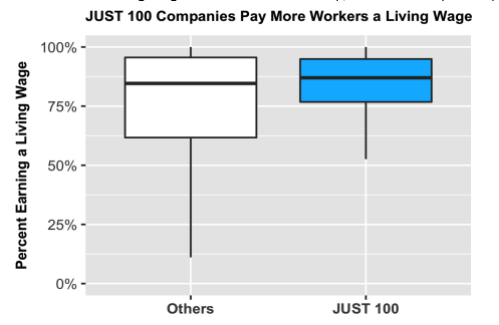
Figure 1: Boxplot of percent of US-based company employees earning a living wage for the 100 constituents of the JUST 100 and for 768 other companies ranked by JUST Capital. Horizontal bold line represents median, top and bottom of box represent 1st and 3rd quartiles, respectively. Vertical whiskers represent range of other observations. Source: JUST Capital calculation.
How satisfied are workers with their compensation and benefits?
An additional and very valuable approach to measuring compensation and benefits is to simply listen to what workers have to say. In partnership with Glassdoor, JUST Capital has gathered a series of aggregate and detailed worker satisfaction ratings for Russell 1000 companies. Figure 2 examines Glassdoor’s compensation & benefits rating, measured on a 1 – 5 scale. The metric represents workers’ response to the question “how satisfied are you with your overall compensation and benefits?” reflecting not only wages, but also additional compensation such as profit-sharing, and benefits such as health insurance. By this measure, JUST 100 companies also perform significantly better than other ranked companies, whether based on the median, first-quartile, or third-quartile. The median JUST 100 company scores 3.7, compared with 3.4 for others. At the first-quartile JUST 100 companies score 3.4 vs. 3.1, while on the third-quartile they score 4.0 vs. 3.6. Statistically, as shown in the Appendix we can again reject the hypothesis that both sets of companies perform equally on this metric with 99% confidence (Table 4).
Fair Pay Compared With Peers
The final wage Metric is fair pay, which JUST Capital calculates by comparing wages across companies using crowd-sourced wage reviews from Glassdoor, adjusted by a county-level purchasing power index and sorted into Glassdoor occupation code classifications to allow cross-company comparisons by job title. Each company’s Metric is based on comparisons with peers by title and assigned a numerical score based on the highest real wage. The final Metric is a percentage that represents how each company compares to its industry. As shown on Figure 3, JUST 100 companies outperform their peers on this Metric at all quartiles. The median JUST 100 company scores 69%, compared with 51% for others. At the first-quartile JUST 100 companies score 58% vs. 37%, while on the third-quartile they score 80% vs. 63%. As shown in the Appendix, while fair pay data is only available for 227 companies, based on a t-test we can again reject the hypothesis that both sets of companies perform equally on this metric at the 99% confidence level (Table 5).

Figure 2: Boxplot of Glassdoor average employee compensation and benefits rating on a 1–5 scale. Source: Glassdoor.
Overall, we find that whether based on employee-reported compensation & benefits ratings, or on JUST Capital’s analysis of employees earning a living wage of fair pay, JUST 100 companies perform meaningfully better on worker pay metrics.
What about financial performance?
While there are many measures of financial performance such as earnings growth or stock market performance, we’ve elected to examine Return-on-Invested Capital (ROIC). This is a Metric that many investors and management teams focus on, and which tends to be less sensitive to the specific choice of starting and ending dates than other financial metrics. Our calculation of ROIC is agnostic to company-specific capital structure. Figure 3 shows the range of 5-year average ROIC for both the JUST 100 and other corporations. The median ROIC of the JUST 100 stands at 11.2%, 1.9% (190 bp) above the 9.3% median for other corporations. This represents a materially higher ROIC in any business context, and which remains consistent at the first and third quartiles of ROIC, favoring the JUST 100 by 1.6%, and 2.7% respectively. To put this figure in context, a 1.9% increase in ROIC would boost a median company in our data set to the 65th percentile, and likely elicit a significantly positive stock market reaction and CEO compensation reward. Table 6 in the Appendix shows the two groups to be statistically different at the 95% confidence level.
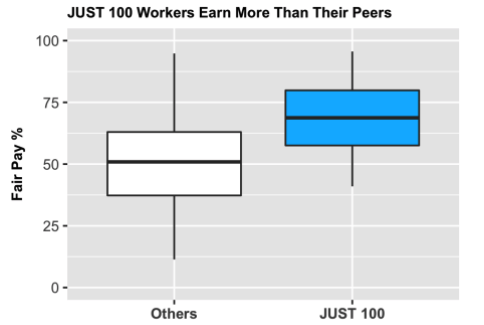
Figure 3: Boxplot of JUST Capital’s fair pay metric. Source: JUST Capital.
Are good pay and high ROIC unique to the JUST 100?
We conducted an additional analysis to evaluate the robustness and uniqueness of the JUST 100’s higher pay and higher ROIC combination. We returned to the full dataset of 897 companies, divided into quartiles of ROIC, and examined whether the highest ROIC quartile also performs well on the wage metrics. If this were the case across the full dataset, then the uniqueness of the JUST 100 would be questionable. As Table 2 shows, the highest quartile of ROIC in the full dataset performs below average on living wage, pay satisfaction, and fair pay. Thus, the conventional wisdom that for most companies higher shareholder returns generally accompany lower wages appears to be correct, and the characteristics of the JUST 100 appear unique and do not extend to the full dataset.

Industry Analysis
We also conducted significance testing of the 32 industries individually, comparing the JUST 100 members with the others in the same industry. Given the small sample size per industry, not every industry showed statistically significant results (Table 7). Of the 32 industries, 21 showed significance for at least one of the four metrics. Of these 21 industries, 19 showed significance in the direction consistent with the JUST 100 performing better than the rest of the industry, and two where the JUST 100 performed worse. This skew of 19 industries performing better and 2 performing worse is consistent with the overall results. The technology hardware industry is worth highlighting. In this industry the JUST 100 performed significantly better than their peers across all three wage metrics. The constituent JUST 100 stocks are F5 Networks, Cisco Systems, Juniper Networks and NetApp. In addition, Pharmaceuticals, Semiconductors, Capital Goods, Consumer Services and Capital Markets performed significantly better in two of the four Metrics. The two industries where the JUST 100 underperformed their peers were Retailing and Chemicals. In these two industries the JUST 100 showed lower ROIC than peers. Table 7 shows results as well as the JUST 100 constituent companies for each industry.
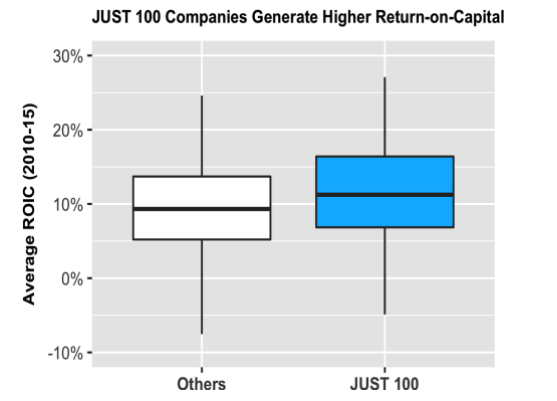
Figure 4: Boxplot of average 2010–15 Return-on-Invested Capital. Uses Return-on-Tangible Equity for financial companies. Source: Company data, JUST Capital.
Conclusions and Further Research
We’ve shown that the JUST 100 set of large, publicly-traded US corporations can pay their workers well and generate superior financial returns. We’ve also shown that this result is even more pronounced for the top-ranked JUST 32, and that these findings do not extend to the full dataset of 897 ranked companies by JUST Capital, making this a differentiated set of companies. These results remain robust when broken down by industry. We have not shown a causal link from higher pay to higher ROIC, but rather that higher pay does not preclude strong financial performance, as measured by ROIC. Nonetheless, differences in industry structure and competitive dynamics across industries remains a topic of further research, particularly for the two industries were the JUST 100 showed lower ROIC. In future research we’ll also evaluate additional dimensions of financial and social performance and the commonality of business models, if any, that make the JUST 100 stand out. In particular, metrics outside the JUST ranking model are of interest. While worker pay and benefits are an important dimension of corporate justness, we also plan to turn our attention to the relationship between financial performance and other areas the public considers important, including leadership and ethics, job creation, environmental impact, supply-chain impact, and community wellbeing.
References
JUST Capital, 2016–2017 JUST Capital Ranking Methodology.
Raff, Daniel and Larry Summers. 1986. “Did Henry Ford Pay Efficiency Wages?” National Bureau of Economic Research Working Paper №2101.
Appendix: Summary Statistics and Hypothesis Tests


